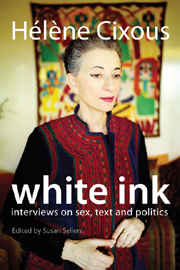Book contents
- Frontmatter
- Contents
- Acknowledgements
- Editor's note
- Preface: On being interviewed
- Part I Writing the enigma
- Part II Writing the feminine
- 5 When I do not write, it is as if I had died
- 6 My text is written in white and black, in “milk and night”
- Part III Writing and politics
- Part IV Writing and theatre
- Part V Writing roots
- Part VI On painting, music and nature
- Part VII Dialogues
- Envoi: But the Earth still turns, and not as badly as all that
- Bibliography of Hélène Cixous's works
- Index
5 - When I do not write, it is as if I had died
from Part II - Writing the feminine
- Frontmatter
- Contents
- Acknowledgements
- Editor's note
- Preface: On being interviewed
- Part I Writing the enigma
- Part II Writing the feminine
- 5 When I do not write, it is as if I had died
- 6 My text is written in white and black, in “milk and night”
- Part III Writing and politics
- Part IV Writing and theatre
- Part V Writing roots
- Part VI On painting, music and nature
- Part VII Dialogues
- Envoi: But the Earth still turns, and not as badly as all that
- Bibliography of Hélène Cixous's works
- Index
Summary
This interview is translated here from “Hélène Cixous: Quand je n'écris pas, c'est comme si j'étais morte”, in Comment travaillent les écrivains [How Writers Work], Jean-Louis de Rambures, 56–63 (Paris: Flammarion, 1978). An unrevised version appeared under the same title in Le Monde (9 April), 20, 1976. The first two paragraphs are by Hélène Cixous.
A method is a word that means nothing to me. I would not follow one, as my work is analogous to a relationship of love.
The text I write is an object of desire to me. Between it and me, there is an exchange that occurs day and night. It does not matter if this happens on paper or not. In some ways, I live with it constantly. All that would happen within me — continuously fermenting emotions, desires, anxiety — I never cease to recapture and rework in order to return it to this other body in the process of maturing next to me. At root, it is precisely as if I made more than another body with my own body.
j-ldr One point is certain: you are a writer who produces in abundance.
cixous I believe I have much to say on this “abundance”. First, from an anecdotal point of view, there is, on the part of the classical editorial houses, a little operation of indirect censorship that consists of leaving manuscripts lying around for two, three, four years.
- Type
- Chapter
- Information
- White InkInterviews on Sex, Text and Politics, pp. 51 - 57Publisher: Acumen PublishingPrint publication year: 2008

